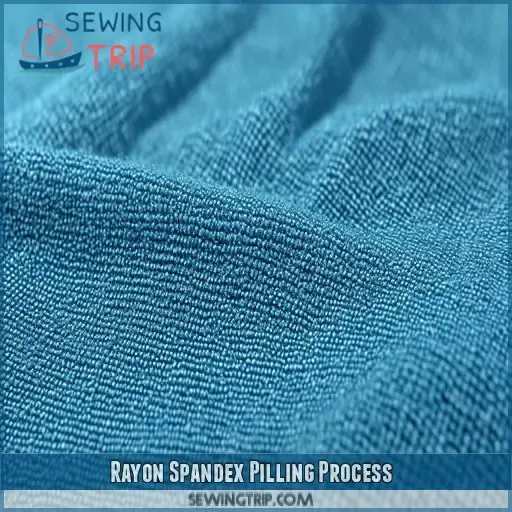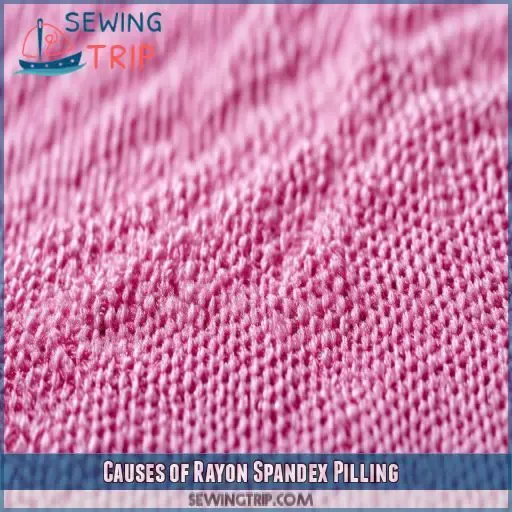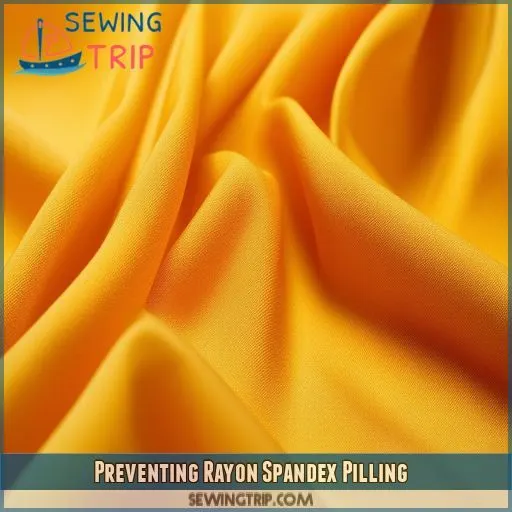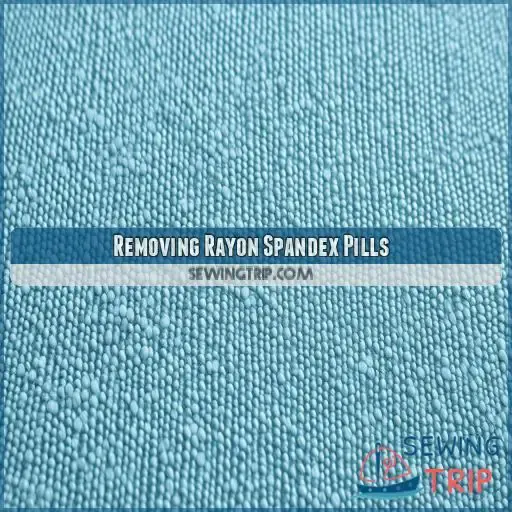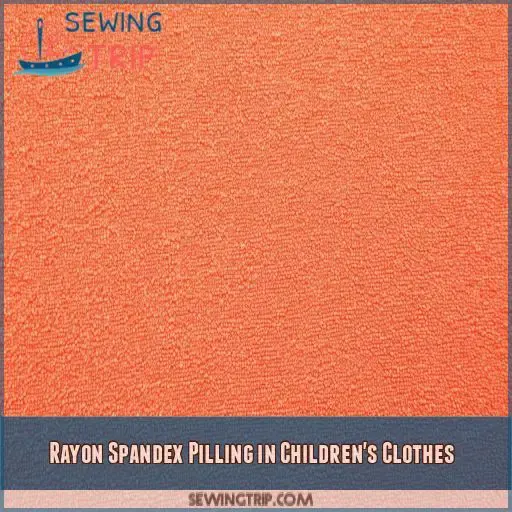This site is supported by our readers. We may earn a commission, at no cost to you, if you purchase through links.
 Unveiling the mystery of fabric pilling, you’ll discover the truth about rayon spandex. Does rayon spandex pill? The answer isn’t straightforward.
Unveiling the mystery of fabric pilling, you’ll discover the truth about rayon spandex. Does rayon spandex pill? The answer isn’t straightforward.
This blend, known for its comfort and versatility, can indeed develop those pesky little balls of fiber. But don’t fret!
You’re about to uncover the secrets behind why it happens, how to prevent it, and what to do when pilling occurs.
Armed with this knowledge, you’ll master the art of keeping your rayon spandex garments looking fresh and pill-free.
Table Of Contents
- Key Takeaways
- Does Rayon Spandex Pill?
- Rayon Spandex Pilling Process
- Causes of Rayon Spandex Pilling
- Preventing Rayon Spandex Pilling
- Removing Rayon Spandex Pills
- Rayon Spandex Pilling in Adult Clothes
- Rayon Spandex Pilling in Children’s Clothes
- Choosing Quality Rayon Spandex Fabrics
- Frequently Asked Questions (FAQs)
- Conclusion
Key Takeaways
- Rayon spandex can be a real pill sometimes! But don’t toss those comfy threads just yet. Understanding the four stages of pilling – from fuzz to full-blown fabric balls – is half the battle in keeping your favorite duds looking fresh.
- Your laundry game can make or break your rayon spandex. Treat those garments like VIPs: gentle cycles, inside-out washing, and air-drying are your new best friends. It’s like giving your clothes a spa day every wash!
- Prevention is worth a pound of cure, as they say. When shopping, be a fabric detective: look for high-quality blends with longer fibers and tighter weaves. Your wallet might grumble now, but your future self will thank you.
- When those pesky pills pop up (and they will, let’s be real), don’t throw in the towel! Arm yourself with a sweater comb or fabric shaver and show those fuzz balls who’s boss. It’s like giving your clothes a stylish buzz cut!
Does Rayon Spandex Pill?
Yes, rayon spandex does pill. This blend is prone to pilling due to its fiber structure, but you can manage it.
Pilling occurs in four stages: fuzz formation, entanglement, growth, and wear-off. Causes include abrasion, friction, and wear from daily use and improper care.
To prevent pilling, opt for high-quality blends, reduce friction, use gentle laundry cycles, and air dry your garments. When pills appear, you can remove them with tools like fabric shavers or sweater combs.
While you can’t completely eliminate pilling, understanding its causes and taking preventive measures will help keep your rayon spandex clothes looking fresh. Stick around to uncover more strategies for maintaining your favorite pieces.
Rayon Spandex Pilling Process
When you’re dealing with rayon spandex, understanding the pilling process is essential to maintaining your garments. Pilling occurs in four stages: fuzz formation, entanglement, growth, and wear-off. Initially, loose fibers emerge on the fabric surface due to abrasion. These fibers then intertwine, forming small knots. As wear continues, more fibers join these knots, creating noticeable pills. Finally, some pills may detach naturally.
Rayon spandex, a blend of natural and synthetic fibers, can be prone to pilling. While rayon offers durability and spandex provides performance, their combination can sometimes lead to increased pilling. Compared to pure synthetics, rayon spandex may pill differently due to its unique fiber structure.
To combat this, pilling prevention techniques and proper fabric care guidelines are critical. By understanding this process, you’ll be better equipped to keep your rayon spandex garments looking fresh and pill-free.
Causes of Rayon Spandex Pilling
Rayon spandex can indeed pill, with several factors contributing to this issue. The fabric blend’s composition, your laundry practices, and how you wear and use the garment all play significant roles in determining the likelihood and extent of pilling.
Fabric Blend Impact
Regarding rayon spandex pilling, the fabric blend plays a key role. This man-made fiber combo is more prone to fabric pills than natural alternatives.
The rayon spandex durability can vary depending on the blend ratio. While it’s often a budget-friendly option, the price point shouldn’t be your only concern.
Understanding fabric defects and care tips will help you make informed decisions about rayon spandex sustainability and fashion trends.
Laundry Technique Influence
Your laundry habits play a key role in preventing pilling on rayon spandex garments. Proper garment care starts with reading the fabric label and following laundry instructions carefully.
To minimize pilling, use gentle cycles, turn clothes inside out, and avoid overloading the machine. Choose mild detergents and skip fabric softeners.
Wear and Environment Effects
Your daily habits and environment play a significant role in rayon spandex pilling. While proper laundry care is essential, how you wear and treat your garments matters too. Friction from everyday activities can lead to fuzz and lint balls, especially in high-stress areas. Here’s what you should know:
- Frequent rubbing against rough surfaces weakens fibers
- Prolonged exposure to sunlight affects dye stability and colorfastness
- Humidity and temperature fluctuations can impact shrinkage risk
Preventing Rayon Spandex Pilling
Now that you understand why rayon spandex pills, let’s focus on prevention. Your first line of defense is fabric selection. Opt for high-quality rayon spandex blends with longer fibers and tighter weaves. Pay attention to garment construction, choosing well-made pieces that’ll withstand wear and tear.
Your wearing habits matter too. Reduce friction by avoiding tight-fitting clothes in high-rub areas. For laundry, treat your rayon spandex with care. Use a gentle cycle and mesh garment bags to protect delicate items. Turn garments inside out before washing, and never overload your machine.
Skip the clothes dryer – air drying is your best bet. When storing, give each piece breathing room to prevent unnecessary rubbing. By adopting these strategies, you’ll noticeably extend the life of your rayon spandex garments and keep those pesky pills at bay.
Removing Rayon Spandex Pills
When those pesky fuzz balls appear on your rayon spandex garments, don’t despair! You’ve got several effective solutions to banish those pills. Start by laying your garment flat on a hard surface, then gently run a sweater comb or fabric shaver over the affected areas. For a budget-friendly option, a disposable razor works wonders too. Just be careful not to apply too much pressure and damage the fabric.
Here are some handy de-pilling tools and techniques:
- Electric fabric shaver: Quick and efficient for large areas
- Sweater stone: Great for delicate fabrics
- Pumice stone: Effective on tougher pills
Rayon Spandex Pilling in Adult Clothes
Regarding rayon spandex in adult clothes, keep an eye out for pilling. This fabric blend offers great durability, breathability, and versatility, but it’s not immune to those pesky little balls. Here’s a quick rundown of how different adult garments fare:
| Garment Type | Pilling Risk | Prevention Tips |
|---|---|---|
| Yoga Pants | High | Wash inside out |
| Tanks/Tops | Medium | Use mesh bag |
| Dresses | Low-Medium | Air dry |
| Skirts | Low | Avoid friction |
To maintain your rayon spandex’s colorfastness and washability, always follow care instructions. Remember, prevention is key! Opt for high-quality fabrics and be mindful of how you wear and care for your clothes. With the right approach, you can keep your adult rayon spandex garments looking fresh and pill-free for longer. It’s like giving your wardrobe a suit of armor!
Rayon Spandex Pilling in Children’s Clothes
Regarding children’s clothes made from rayon spandex, pilling can be a real headache for parents. Kids are always on the move, putting their clothes through the wringer.
The good news? Rayon spandex’s durability and elasticity make it a top choice for active little ones. However, you’ll want to keep an eye out for those pesky pills. The fabric’s moisture-wicking properties and comfort level are great, but they don’t make it immune to pilling.
To extend the longevity of your kiddo’s wardrobe, focus on prevention. Wash their clothes inside out, use gentle cycles, and avoid over-drying. If pills do appear, don’t panic! A fabric shaver can work wonders.
Choosing Quality Rayon Spandex Fabrics
When choosing rayon spandex fabrics, you’ll want to assess their potential for pilling and overall quality. Look for higher-density weaves with finely twisted yarns, and check the fabric blend to minimize pilling risks.
Rayon Spandex Pilling
Regarding rayon spandex, pilling can be an irritating issue. However, this fabric blend’s inclination to develop those bothersome small balls isn’t inevitable.
You’ll notice that rayon durability differs, while spandex’s drawbacks include its tendency to pill. Natural fiber benefits often prevail here, but don’t dismiss rayon spandex just yet.
Your fabric care actions and ethical fashion choices are essential in preventing and controlling pilling.
Fabric Quality Check
Now that you’re aware of rayon spandex pilling, let’s focus on choosing quality fabrics. To guarantee durability and longevity, follow these steps:
- Check fiber density: higher density means less pilling.
- Compare fabrics: Feel the texture against high-end alternatives.
- Inspect stitching: Look for secure, even seams.
- Examine fasteners: Ensure they’re sturdy and well-attached.
Pill Prevention Techniques
Now that you know how to check fabric quality, let’s focus on preventing pills. Your laundry routine plays an important role. Opt for hand washing or gentle cycles, and use a sweater comb for maintenance.
When shopping, prioritize rayon spandex blends with higher fabric density and natural fibers. Pay attention to garment construction, as better-made clothes resist pilling.
Frequently Asked Questions (FAQs)
How do you keep rayon from pilling?
To prevent rayon pilling, wash garments inside out on a gentle cycle. Use mesh bags, avoid fabric softeners, and air dry. Opt for higher-quality rayon blends with longer fibers. Regularly remove pills with a fabric shaver or sweater stone.
Is rayon spandex a good fabric?
Rayon spandex can be a great fabric choice. It’s lightweight, breathable, and offers excellent stretch. You’ll appreciate its wrinkle resistance and beautiful drape. However, it requires careful washing and may pill over time with frequent wear.
Does rayon have pilling problems?
You might be surprised, but rayon can indeed pill. Despite its smooth feel, this fabric isn’t immune to those pesky little balls. However, the extent of pilling depends on various factors, including the fabric blend and care techniques.
What fabric is worst for pilling?
You’ll find that synthetic fabrics like polyester and acrylic are the worst offenders for pilling. Their short fibers tend to break and tangle easily, creating those pesky little balls on your clothes. Watch out for blended fabrics too!
How does rayon spandex compare to cotton for pilling?
You’ll find rayon-spandex blends more prone to pilling than pure cotton. While cotton can pill, especially if it’s a looser weave, rayon-spandex’s synthetic fibers tend to form pills more easily. Proper care can help minimize pilling for both fabrics.
Can fabric softeners reduce pilling in rayon spandex blends?
Imagine a soft shield, protecting your fabric’s fibers. Sadly, fabric softeners won’t reduce pilling in rayon spandex blends. They can actually weaken fibers, increasing pilling. Instead, use gentle washing techniques and avoid fabric softeners to maintain your garment’s quality.
Does the color of rayon spandex affect its pilling tendency?
Color doesn’t directly impact pilling in rayon spandex. It’s the fabric’s structure and quality that matter most. You’ll find that dye processes can affect fiber strength, but it’s minimal compared to other factors like weave and fiber length.
How long does rayon spandex typically last before pilling?
Picture a garden: rayon spandex garments are like delicate flowers. You’ll typically see pilling within 3-6 months of regular wear. But with proper care, you can extend their life, keeping them bloom-fresh for longer.
Are there specific brands known for pill-resistant rayon spandex?
You’ll find brands like Tencel and Modal offering more pill-resistant rayon spandex blends. They use longer fibers and advanced manufacturing techniques. However, no rayon spandex is completely pill-proof. Regular care and proper washing still matter for longevity.
Conclusion
You’ve unraveled the mystery: rayon spandex can indeed pill. But armed with knowledge, you’re now equipped to tackle this challenge head-on.
From understanding the causes to mastering prevention techniques, you’ve gained valuable insights into maintaining your favorite garments. Remember, quality matters when choosing rayon spandex fabrics.

